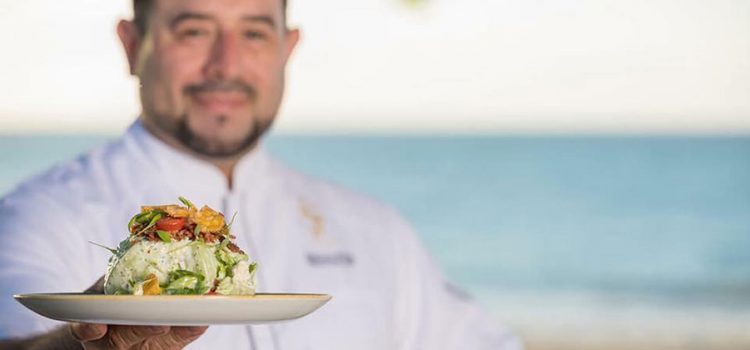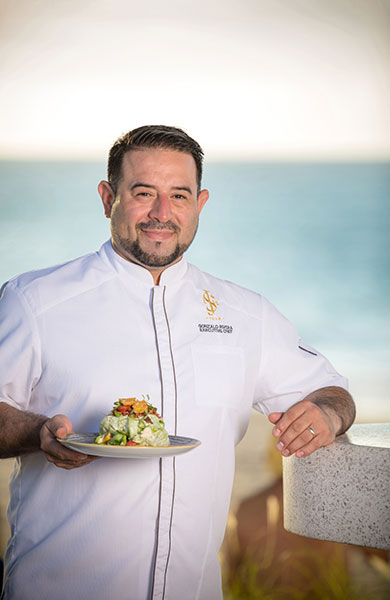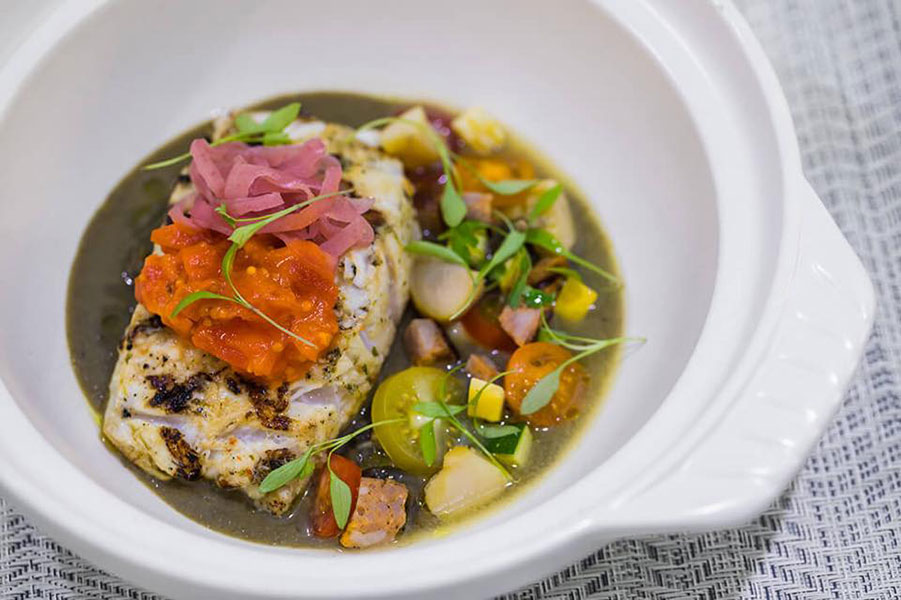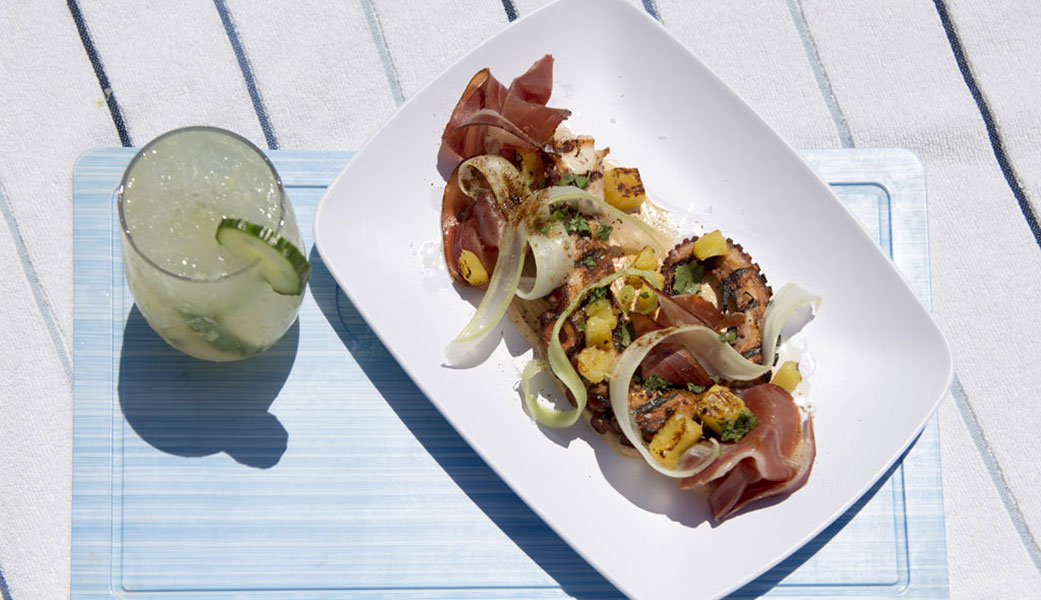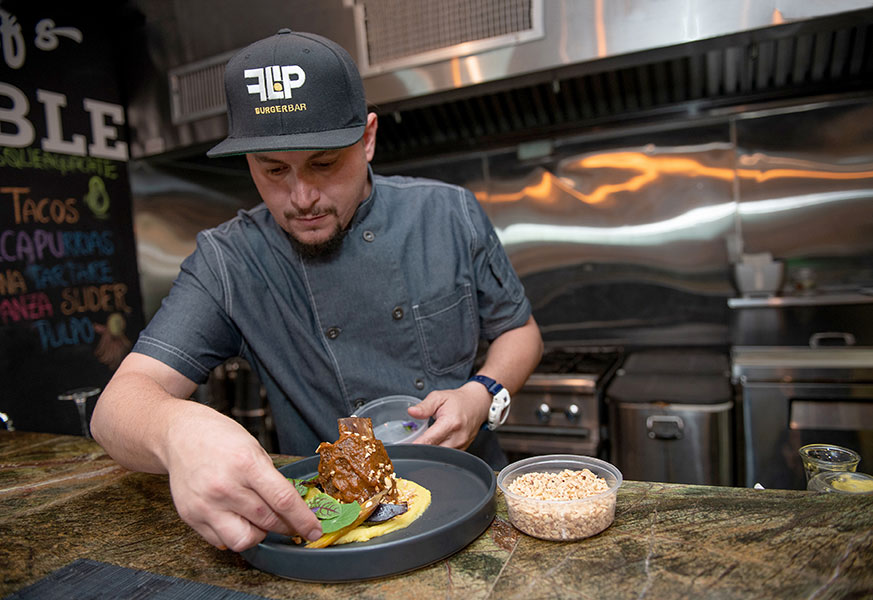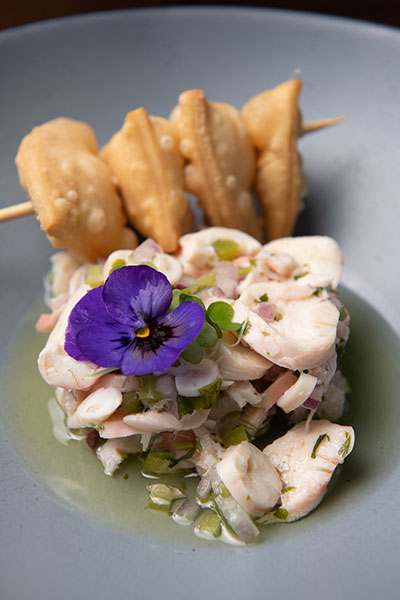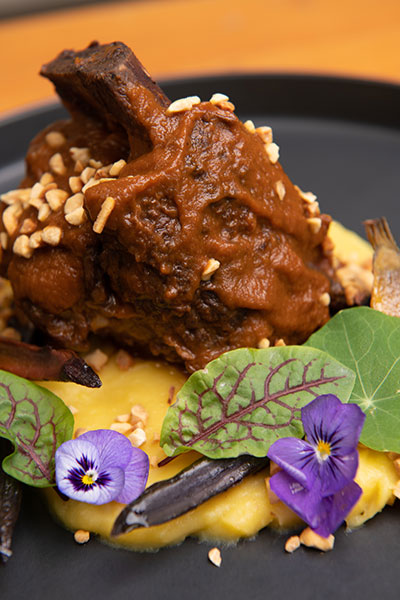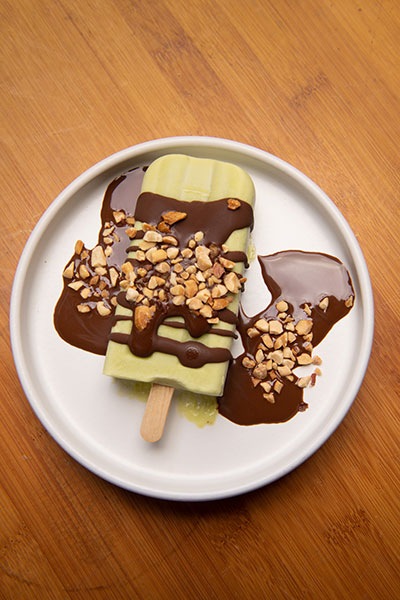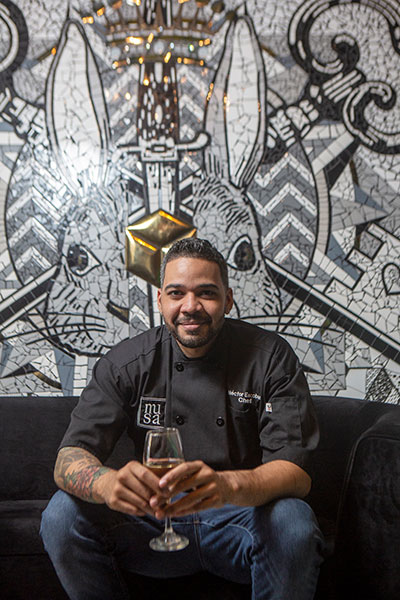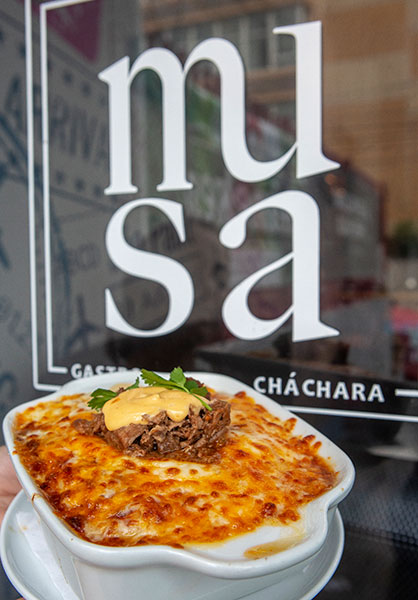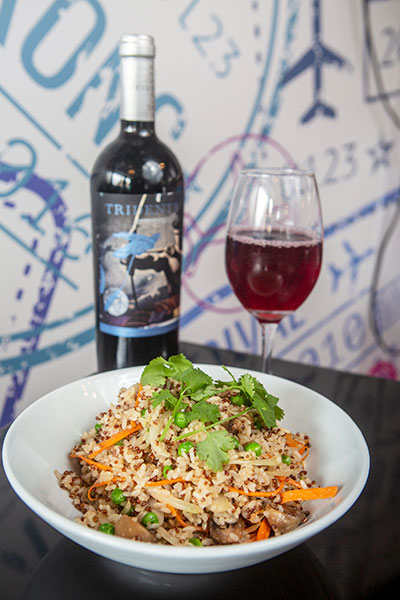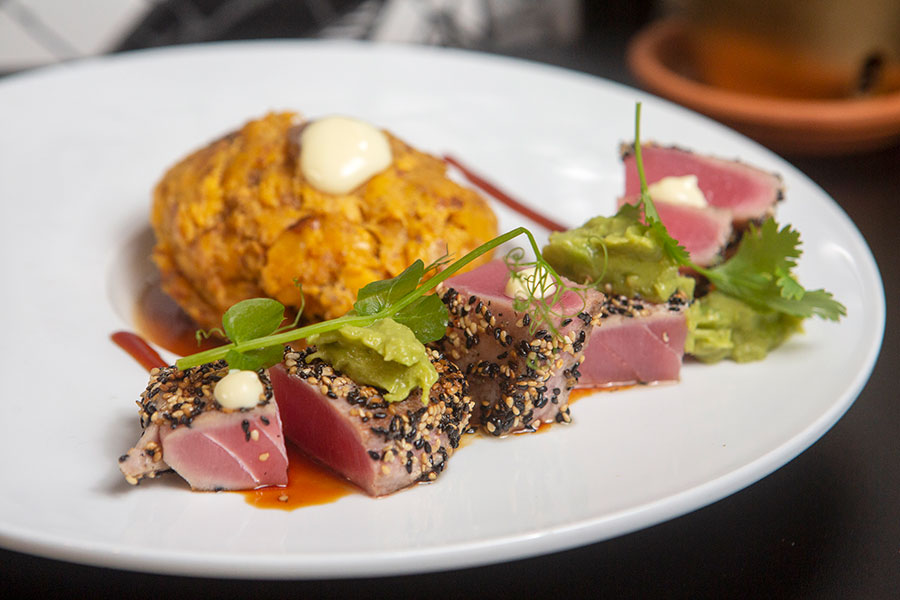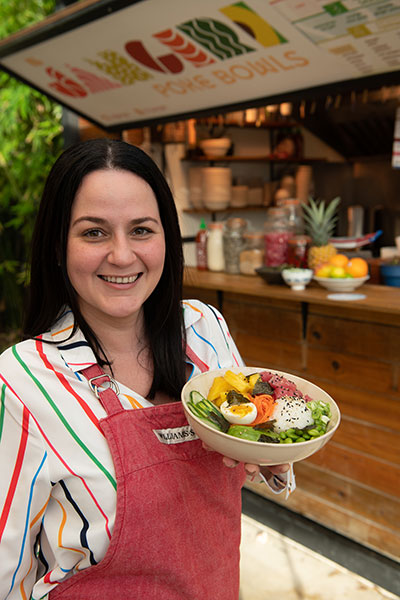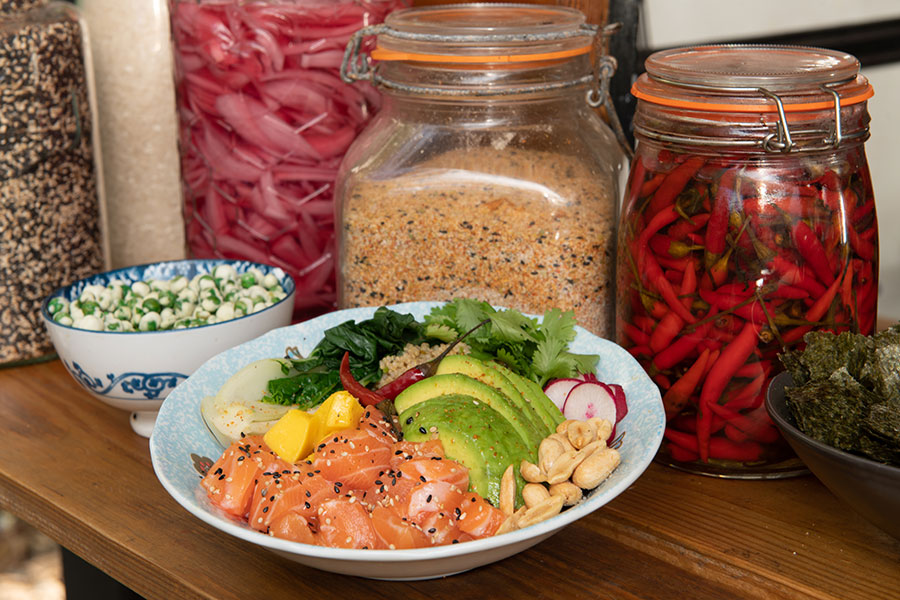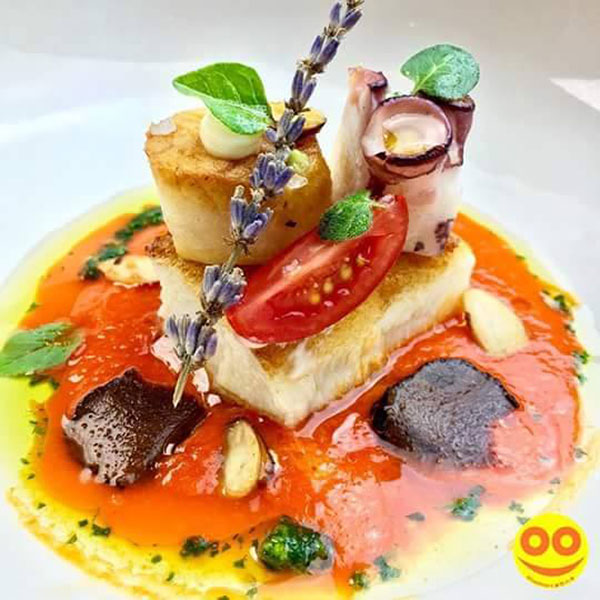Discovering all the natural and cultural diversity of this surprising island fills every trip to Puerto Rico with assorted pleasures, and none may be deeper and more satisfying than the obligatory culinary tour in pursuit of local flavor.
We don’t just mean trying cocina criolla, Puerto Rico’s own contribution to world gastronomy that includes such iconic dishes as mofongo (mashed fried plantains), lechon (roast suckling pig), pasteles (a local tamales), arroz con habichuelas (rice and beans), and bacalaitos fritos (fried cod fritters). These beloved traditional foods go straight to the soul of island cuisine, which is still very much a part of the local food scene. But thanks to the island’s burgeoning and ever evolving gastronomy and the skills of talented young chefs, San Juan is the exciting food capital of the Caribbean; the crossroads of flavors blowing in from the multiple cuisines of the region and into kitchens, big and small that create divine fusions of tastes and new and memorable dining experiences.
“Puerto Rico’s gastronomic scene is super cool right now,” said star Chef Rene Marichal. “There are lots of young people with food proposals that are fun and very well conceptualized. I have had the opportunity of traveling a little, both for pleasure and to cook in different countries and truthfully, we have nothing to envy anyone. Our gastronomy is very rich, full of flavors, aromas and textures.”
San Juan’s food scene is highly diverse, encompassing a wide variety of choices from hot spots and high-end hotel restaurants to food trucks and concepts like Il Nuovo Mercato, a high quality-food court and market rolled into one incredible social-dining space, and Lote 23, an open air food hall in the heart of the city with 16 different chef driven food concepts serving the public out of stalls and Airstream trailers. The talented men and women helming the kitchens of these various enterprises are hard-working professionals who think, breathe, and talk food with gusto and passion. Bienvenidos reached out to some of the most outstanding chefs currently wowing gourmands and diners of all ages and tastes to find out what they are like and their approach to cooking. As different as they all are, one common theme emerged from the interviews and that is the amazing level of commitment these men and women have towards their craft and their unflagging dedication to what they do.
Take Gonzalo Rivera, the executive chef of El San Juan Hotel in Isla Verde, one of San Juan’s most famous and iconic hotels. He easily puts in 14 hour-days and thrives on the satisfaction of pleasing diners. “What attracts me (to this profession) is to see my guests happy when they are savoring my dishes and my cooks learning from me and being successful,” said Rivera, previously the executive chef of Boca Beach Club, A Waldorf Astoria Resort in Florida.
An executive chef wears more than one toque, head of the kitchen but also a manager tasked with overseeing staff, ordering inventory and controlling costs. As El San Juan’s executive chef, Rivera is in charge of four restaurants (Caña, Aquarelle, which is about to be renovated and get a new name, El Cafecito and the Chandelier Bar in the lobby) and all banquet activities held at the hotel. “In high season we can be serving up to 3,500 meals per day,” said the 41-year-old chef who supervises a staff of 70 people.
Rivera, whose parents were migrant workers, grew up in Gridley, a California town of 4,000 residents. His first industry job was in nearby Chico, washing dishes at a friend’s newly opened restaurant. Two months after being hired the cook quit and his friend set him up in the kitchen. “It “fascinated me,” Rivera said. He went on to study at the California Culinary Academy, earning an Associate of Arts degree in Culinary Arts and Chef Training. The academy is now Le Cordon Bleu. He later went to work with Chef Michael Mina, celebrity chef with a stateside chain of eponymous restaurants who was a mentor to Rivera, teaching him the value of integrity and the importance of details, using the best ingredients and presentation.
Having worked in both hotels and independent restaurants, Rivera sees little difference between the two settings but did insist on the importance of excellence. “At a hotel like El San Juan, we must always distinguish ourselves as the best in the Caribbean and that is how we run the entire operation. From the restaurants to the banquets and catering,” said Rivera.
Menus, featuring 15 to 25 dishes, are changed every three months depending on seasonal ingredients. The hotel buys a lot of food products locally based on quality and availability. Rivera said that “we eat with our eyes,” so creating dishes is all about making an initial impression and then wowing the diner with the properties of the food such as its crunchiness, creaminess, or acidity. “A diner comes to delight his palate. A dish should always be like a Russian roller coaster: the view, the aromas, the texture,” he said. “The techniques we use are slow and low.”
When he was a little boy, Rivera dreamed of a baseball career. Still, some of his dearest moments are the hours spent in the family kitchen with his paternal grandmother who “was very important in my life.” He would watch her cook though he was not allowed to taste anything. As a high school student he took a home economics class. “I started making pies and cakes to compete and always won a blue ribbon,” said the chef. By the time he had his first experience working in that friend’s restaurant, he was fully hooked.
Xiomara Bermudez is the Pastry Chef at Il Nuovo Mercato’s Starbene Caffe. Her work day starts at 5 a.m. and it is anyone’s guess when it will be over. Her shift can easily run 12 hours yet she thrives on the challenge.
“The most challenging (part about the job) is being able to complete all the duties of the day and deliver the quality and consistency the client looks for. It doesn’t matter if you are a man or a woman, this career is for a person who is passionate and loves what they do every day, that’s the difference, the love with which you do things,” she said, adding that her work also required “a lot of perseverance.”
A graduate of the culinary program at the former MBTI Business Training Institute, Bermudez said her industry experiences include working for a company that made traditional Puerto Rican sweets and assisting chefs, including the esteemed Augusto Schreiner, at gastronomic events held by Saborea Puerto Rico. “Any event that came up I would go and help, I wanted to learn and develop,” she said. In 2016 Bermudez was a part-time chef at the AFDA Fraternity in Condado when she found out that an Italy-based company was recruiting for its new Puerto Rico business, Il Nuovo Mercato. Hired in December as a lead pastry cook, she rose to pastry chef within three months. Besides overseeing the dessert department, she handles purchases and is in charge of Starbene’s cleanup and organization. It helps, she said, that she works with a marvelous team of 30 people, out of 150 working at Il Mercato.
“We produce quite a lot, around 300 bite size pastries daily and week-ends, 280 liters of gelato weekly, among other varieties of sweets we probably produce more or less 2,500 items weekly, sometimes more, including baguettes, brioche, milk bread, croissants, cheese turnovers. All these are artisanal products made with flour with no preservatives or potassium bromate. Everything is home made,” said the 35-year-old mother of two teen boys.
Il Nuovo Mercato supports local agriculture. Some of the products purchased locally include fresh milk, eggs, vegetables, pineapples, papayas, and limes. Meanwhile, finding ways to avoid throwing out food has led to at least one sustainable practice that also saves the company money. Bermudez explained that all unsold French bread is used to make a popular bread pudding. First the crust is removed and then the entire inside dough is culled for the confection of the bread pudding which is made with milk instead of with water for extra tastiness, Bermudez said.
Other popular desserts at Starbene Caffe are artisanal cookies made with different ingredients such as anisette or almond dough, lemon cream cake, and, of course, gelato. Bermudez said the gelato is made the Italian way using ingredients flown expressly to the island from Italy. She would not give away the secret formula but did reveal one clue: Italian ice cream is a lot creamier than its stateside counterpart.
Talk about having a lot on your plate. At 39, Chef Rene Marichal is co-owner of three restaurants: Avocado, Argento, and Wok It. And there is more to come. “In December we are opening Flip BRGR Bar at Lote 23, in January we are opening another Wok It at Plaza Escorial, and in February, together with Chef Raul Correa and Chef Xavier Pacheco, we are opening Bacoa, Finca y Fogon in Juncos,” said the chef.
Marichal is a natural at what he does. In fact he did not even study culinary arts but instead earned a Bachelor Degree in psychology from Interamerican University of Puerto Rico and put in two more years of post-graduate studies in industrial and organizational psychology at Carlos Albizu University. “I never worked for anyone, in 2007 I very daringly opened my first business in Hato Rey, The Fresh Grill,” he said, noting that psychology has come in handy in terms of structuring, organizing, and understanding a business.
Though he has no formal training, Marichal always loved cooking and as a kid relished being in the kitchen with his mom and grandmother. He also has an appreciation for fresh fish thanks to his 25 years as a sport fisherman, another reason he credits for his passion for the kitchen. Simplicity is his defining trait as a chef. “My cooking is simple and fun, without pretensions. It is an homage to my mother and grandmother,” Marichal said. As for the success of a dish, “it boils down to this phrase: Think global, act local. In other words, with a local product I can create dishes with the influences of any country. I love to work with fresh fish, especially Cartucho (queen red snapper).”
The food at Avocado is creative Puerto Rican cuisine while Argento features traditional dishes from Argentina and Italy. Wok It is Asiatic cuisine with Puerto Rican influences. “We have our lo mein noodles, made in Caguas by a Chinese man, and clients are free to choose between seven sauces, all designed by me, different proteins (char siu pork, fried meat, chicken chicharron or chicken cracklings, longaniza or pork sausage, tofu and more), vegetables and toppings. The creative combinations clients can make are endless. It is lots of fun,” Marichal said.
In speaking with San Juan’s talented chefs another common theme arises: the imaginative concepts behind their restaurants. Take Musa. Enclosed on the ground floor of a nondescript building on colorful Cerra Street in Miramar, this popular hot magnet for foodies is the creation of Chef Hector Escobar and his business partner, Yamil Rojas. The locale is small but comfortable with black lucite tables and chairs, small framed mirrors looking down from the ceiling, chandeliers over the bar area, Andean tablecloths and travel-inspired wallpaper decorated with passport stamps and airplane windows. Musa changes its menu and decor every three months and the current travel motif is the selected theme for its fifth season, the restaurant as a journey to other cultures and cuisines, in this case the cooking of Peru where Escobar and Rojas recently traveled bringing back rich personal experiences that were transmuted into 10 different dishes on top of the regular menu of an additional 17 choices. The next leg of the trip will be Spain.
“Musa is a space that allows me to be free… where I can express what I feel,” said the soft spoken Escobar, a graduate of the culinary arts program at Universidad del Este in Carolina. Cooking interested him since he was a small boy playing with his cousin’s toy kitchen. At 15, he got his first industry job washing dishes at Picoteo restaurant in El Convento Hotel in Old San Juan. Later, he worked for Vin Santo at the Holiday Inn in Isla Verde (now the Verdanza Hotel), went on to Dragon Fly and Parrot Club and then settled down at Il Molino restaurant in the Ritz Carlton in Isla Verde for a nine-year residency as sous chef. By 2016 he felt ready to launch his own restaurant, a project that took one year before it could be turned into a reality.
For Escobar, who is 33, food is not only personal expression but a way to communicate and show “how rich we are as a culture.” Despite an initial false start that required refining the menu and a temporary closing due to hurricanes Irma and Maria, Musa has been pretty much a success from the beginning thanks to its formula of re-imagined Puerto Rican classics. Escobar likes to tweak tradition and surprise the diner without necessarily shaking the person from their comfort zone. As he sees it, people want tasty food, good portions and a touch of creativity “but not to the point of confusion.”
In tweaking the classics, Escobar will take a popular food like say alcapurrias, a doughy pocket made from root vegetables, and use a duck filling instead of the traditional meat. Or he will take bacalaitos, another beloved delicacy in Puerto Rico, and use snapper as his main ingredient rather than the customary cod. The chef also likes bringing together unlikely food combos like a Mac Cheese served with ropa vieja (shredded meat and vegetables), one of the restaurant’s signature dishes, steak dumplings with bits of sweet plantains and peppers or, a brunch favorite, French Toast stuffed with cream cheese and bacon with fresh berries and a Walnuts Caramel Sauce.
However idealized his view of cooking as a means to self expression, Escobar is also practical about the restaurant business and thinks that food can’t be the sole attraction. “People don’t just go to a restaurant for the food, they look for, they demand good cocktails and entertainment,” he said, pointing out that a singer performs at the restaurant on Friday nights and that Sunday brunch occasionally features a magician. At Musa, “there is always something going on.”
And because the island’s economy is still on shaky grounds, Escobar is doing his share to give diners a break. On Tuesday, for example, the restaurant runs a special $30 lunch offer for two people.
Natalia Rivera Vazquez’ El Jangiri, one of the 16 chef driven concepts at Lote 23, offers a refreshing take on fast food. “My focus is to offer food that is fresh, healthy, and accessible and fast,” said the spirited 34-year-old chef who was recently hired as executive sous chef at The Vanderbilt Hotel in Condado where she had worked a few years ago, first as Banquet Chef and later as Chef de Cuisine at Ola Restaurant.
Rivera said her love of cooking goes back to her youth. “I always wanted to be a chef; I was born with that in my blood.” Still, she flirted with the idea of being a chemical engineer and for two years studied at the Polytechnic University of Puerto Rico until she faced up to reality. “I told myself: This is the moment of truth. You have to go for it.” “For it” was a cooking career so she enrolled in the culinary arts program at the Universidad del Este. Additionally, Rivera trained in some of New York’s top kitchens at Le Cirque, Le Bernardin, Cafe Boulud, Battersby, and Franny’s, a popular Brooklyn restaurant that closed last year. Rivera backed this training with “lots of eating” and plenty of reading about cooking, restaurants but also other topics. “You can learn from everything,” she said. Her work experience in Puerto Rico includes stints at El Convento Hotel in old San Juan and La Concha Hotel in Condado.
El Jangiri serves up “build-your-own” bowls of fish and vegetables and the most popular dish on the menu is fresh tuna paired with avocado. The name of the business is a play on Hangiri, the wooden bowl Japanese use to cool and season sushi rice. “It sounded like Jangueo (Spanglish for hanging out) and to me it seemed perfect,” Rivera said. She loves classic cuisine and thinks that “nothing is better than a well roasted chicken or a good cut of meat carefully cooked.” Her approach to food is based on simplicity. “I think that less is always more and that each product should shine for what it is,” said the chef who gratefully acknowledged the mentoring she received from one of Puerto Rico’s top kitchen stars, Juan Jose Cuevas. Cuevas is the executive chef of 1919, the flagship restaurant at The Vanderbilt, and is now her boss. “His food is incredible,” she said.
Vegetables play a big role at El Jangiri and Rivera buys as much locally as she can. “The quality of something that is grown in our land is far superior plus you have the satisfaction of supporting our working people,” she said. “Things that will always be local in my kitchen are eggplant, cucumbers, pineapple, and ginger. The list is long.”
The mother of a little girl she calls her inspiration, Rivera looks on her profession as a vocation. “I think we all are born with a vocation. There is nothing in the world I could do better or with more passion, or that makes me happier than to be in a kitchen,” she said.
Carlos Portela’s Orujo Taller de Gastronomia has no set menu. The restaurant, named after a type of aguardiente made in Spain from grapes, is built around the concept of the degustation menu, a formula that has earned the chef rave reviews and allows him the opportunity to let his creativity soar.
“Each dish is its own little masterpiece… It isn’t a meal. It’s an event, and it’s worth it,” a resident from Seattle, Washington, raved on Yelp.com after eating at the restaurant.
Located in Caguas, about half an hour away from San Juan, Orujo is a showcase of fine dining and a restaurant that personalizes the experience of eating out: diners are invited to visit the kitchen or, ahead of ordering, are grilled by the chef as to food allergies, their likes and dislikes. Orujo always had as its aim to create a space where the lover of good food and wine would have a place in which to enjoy the local cuisine in the manner of a modern degustation,” said Portela, who runs the restaurant with the help of his wife Armalie Perez.
The tasting menu showcases anywhere from three (the short version) to 15 exquisitely plated courses that one can order with selective wine pairings. The food is heavily influenced by the availability of seasonal products. Portela favors local products and ingredients among which favorites are recao (culantro), calabaza (Puerto Rico’s own pumpkin), name (yam). What he can’t buy locally, he imports. Foie grass he orders from New York or Canada. Meats such as Iberian ham, pork, rabbit, and lamb are imported or purchased from local farms; the same for fish and shellfish, with local fishermen delivering their catch straight to the restaurant. Portela described himself as a spontaneous chef who likes to cook dishes that exalt the flavors of Puerto Rico. His cuisine is infused with the influences of North America, Europe and the Caribbean. He’s comfortable with modern and traditional cooking techniques. “Our cuisine is very simple, but it vies for perfection in its method of preparation, taste and beautiful presentation,” he said.
When he was a kid, Portela dreamed of being a musician in a rock band, or perhaps an astronaut, but at 16 he got his first job working in a school cafeteria and he developed an interest in cooking. He said that what particularly drew him to a cooking career was that it interfaced with so many different areas like management, nutrition, science, art, agriculture, and human relations. After studying in Puerto Rico, Portela headed to the U.S. where he graduated from the prestigious Johnson and Wales Culinary Institute in Providence, Rhode Island. In 2007 he joined the team of Ramiro’s Taller de Cocina in Valladolid, Spain, where he was exposed to the craft of master chefs like Ferran Adria and Andoni Luis. Subsequently, he worked in the U.S. and then returned to Puerto Rico to start his own restaurant. It opened May 1, 2014.
“At Orujo, creativity is limited only by the ingredients and available equipment. We always look for new ways to present, combine elements and plate in accordance with the season,” said the 43 years old chef.
With so many talented chefs around and so many choices for eating out one might conclude that this is Puerto Rico’s culinary golden age. “Puerto Rican gastronomy is going through a great moment. There is a movement of talented men and women cooks who aim to take the island’s cuisine to the highest levels and to world class status,” said Portela. “It’s a movement that is very united and in which there is mutual support for the development of a better industry, one that is responsible to the environment, the earth and society.”
“I love what is going on in the island,” said Rivera. “There is a lot that is good and all kinds of it. From food trucks, kiosks, elegant restaurants and family run ones. There are so many tremendous places to visit. You have to go out and try everything.”

